Set Up iCloud
iCloud setup, in and of itself, is easy and largely self-explanatory: you enter your Apple ID and password, and click a few buttons on each of your devices. There’s no software to install on a Mac or iOS/iPadOS device and it includes only a few options you can turn on or off. You have to go through a few more steps under Windows.
However, you may encounter questions about certain settings, wonder how to handle multiple iCloud accounts, or need help disabling iCloud. So in this chapter I walk you through those topics for Macs and iOS/iPadOS devices.
If you’ve already set up iCloud, you can skim most of this chapter, starting with Set Up iCloud on a Mac—just to make sure you’ve enabled all the features you may want to use.
Update Your Software
If you want to access all the latest iCloud features, make sure the Apple software that uses iCloud is up to date on each platform you use. Here’s what you need to do:
iOS/iPadOS: For any iOS or iPadOS device you haven’t already upgraded to iOS 13 or later, tap Settings > General > Software Update and follow the prompts to install the latest update.
Mac: Choose Apple > App Store and click Updates. If newer versions of macOS, Photos, iTunes, or the iWork apps (Pages, Numbers, and Keynote) are found, follow the prompts to install them. In particular, be sure to install 10.15 Catalina—a free upgrade—if you have not already done so and your Mac supports it. (If you are contemplating a major upgrade from an earlier version of macOS, look for steps in my book Take Control of Upgrading to Catalina.)
Windows: First, download and install the latest version of iTunes; if you have a previous version installed, you can use Start > Apple Software Update. Then download and install iCloud for Windows from the Microsoft Store.
Apple TV: For information on updating the Apple TV software, see Apple’s article Update the software on your Apple TV.
Set Up iCloud on a Mac
Your Mac may already have prompted you to set up iCloud (in which case, just skim this section to make sure everything is configured to your liking). If not, you can set it up manually. The exact sequence of steps depends on your circumstances.
The first thing to know is that all versions of macOS through Mojave, had an iCloud pane of System Preferences, and that is (quite logically) where you went to configure iCloud. Starting in Catalina, however, Apple made iCloud a category within the new Apple ID preference pane. Most (but not all) settings remain in the same relative places.
To begin, I’ll show you what to do under both Catalina (or later) and Mojave if you ignored any prompts to set up iCloud earlier (or if you subsequently signed out completely).
Follow these steps:
If you’re running Catalina or later, go to System Preferences > Apple ID > iCloud (Figure 1). Or, in Mojave, go to System Preferences > iCloud (Figure 2).
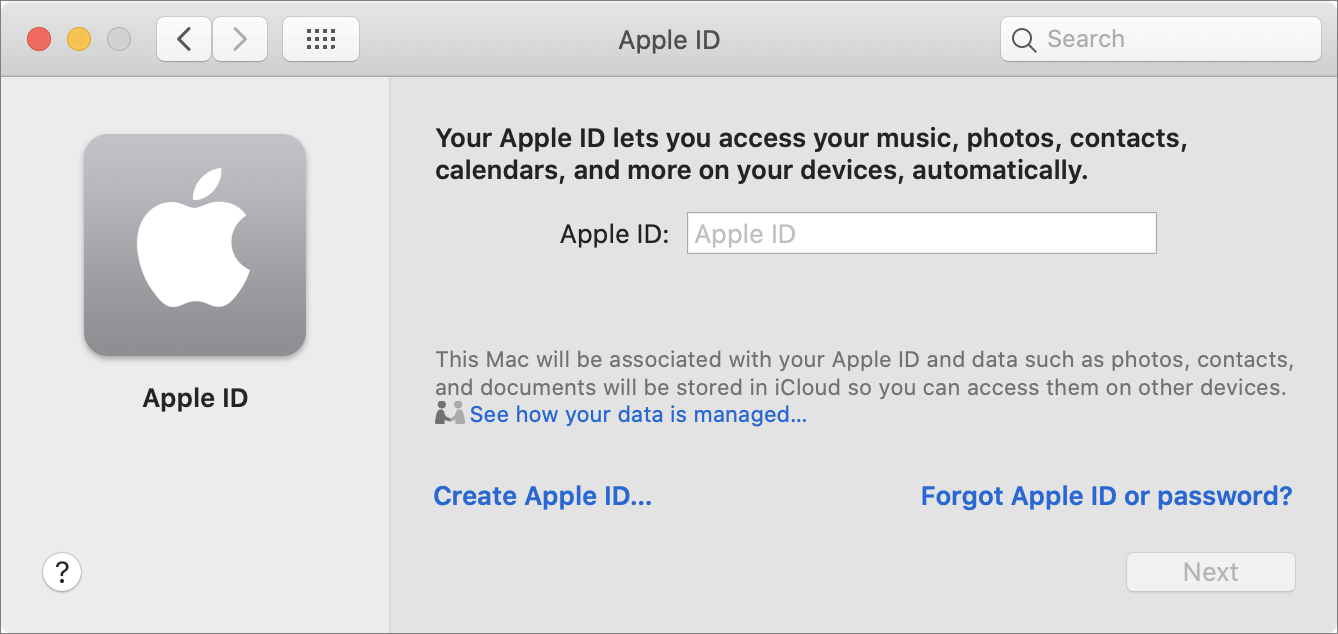
Figure 1: Starting in Catalina, iCloud preferences are a subset of Apple ID preferences, so start by signing in on the Apple ID pane. 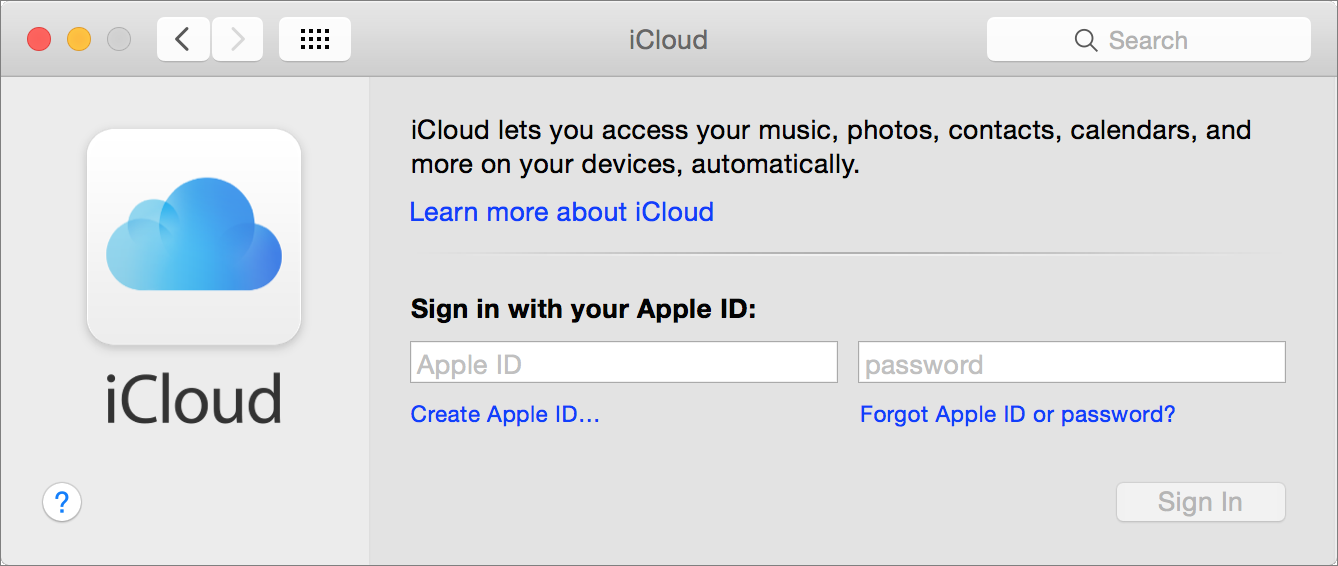
Figure 2: Mojave and earlier use the iCloud preference pane. In Catalina or later, enter the Apple ID you want to use (see About Your Apple ID for more details), click Next, enter your password, and click Next again. In Mojave, enter your Apple ID and password and click Sign In. (In the unlikely event that you don’t yet have an Apple ID, refer back to About Your Apple ID for advice, then click Create New Apple ID and follow the prompts to create one now.)
Next, you’ll encounter a series of questions. You might see only a couple or nearly a dozen, depending on your operating system and circumstances. Because there are so many variables, all I can do is point out a number of the most common alerts you’re likely to see during the process:
The iCloud Terms of Service may appear. If so, agree to them.
You may also be prompted to reenter your iCloud password, or to enter the password for your Mac’s user account, or both (possibly more than once). Be sure to read the text carefully to see which password it’s asking for.
Your Mac may ask (Figure 3) if you want to enable a commonly used set of services. That includes contacts, calendars, reminders, notes, Safari bookmarks, iCloud Keychain, and documents. It also sweeps in mail, even though it’s not explicitly mentioned in the list. But it excludes your Desktop and Documents folders by default. It may also ask, separately, if you want to use Find My Mac. Unless you have a particular reason not to, leave both checkboxes selected and click Next.
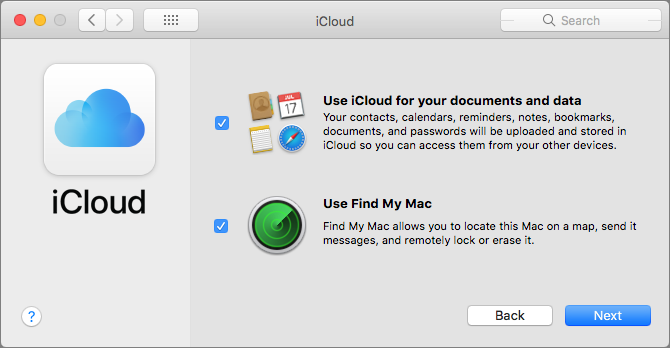
Figure 3: You can set up most iCloud services without any further effort by clicking Next here. You may be prompted to click Allow to confirm that iCloud can use your Mac’s location for Find My Mac.
If you’re signing back in after having signed out, you may also be asked whether you want to merge data from apps such as Calendar, Safari, and News with iCloud—you almost certainly do!
You may also find that, even after signing in, the window says “Update Apple ID Settings.” If so, click Continue and follow the prompts, which may ask you to reenter your iCloud password and/or your Mac’s user account password. I don’t know why these extra steps are sometimes required, but be patient and work your way through them.
Once you’ve responded to the alerts, you’ll see either the full Apple ID preference pane, with the iCloud category selected (Catalina or later; see Figure 4) or the full iCloud pane (Mojave; see Figure 5). Most of the individual checkboxes will probably already be enabled.
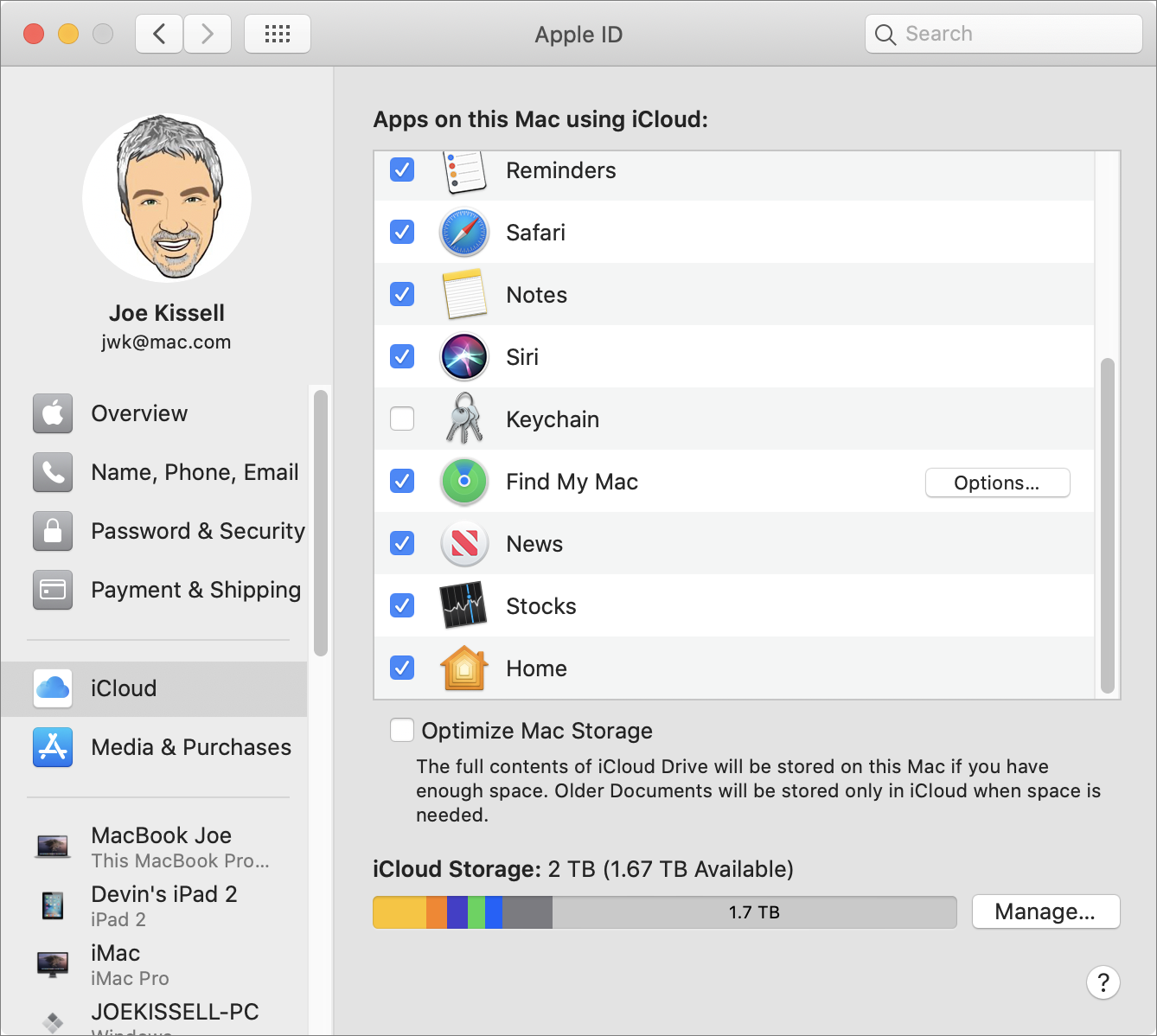
Figure 4: iCloud is finally (almost) ready to go in Catalina (or later). 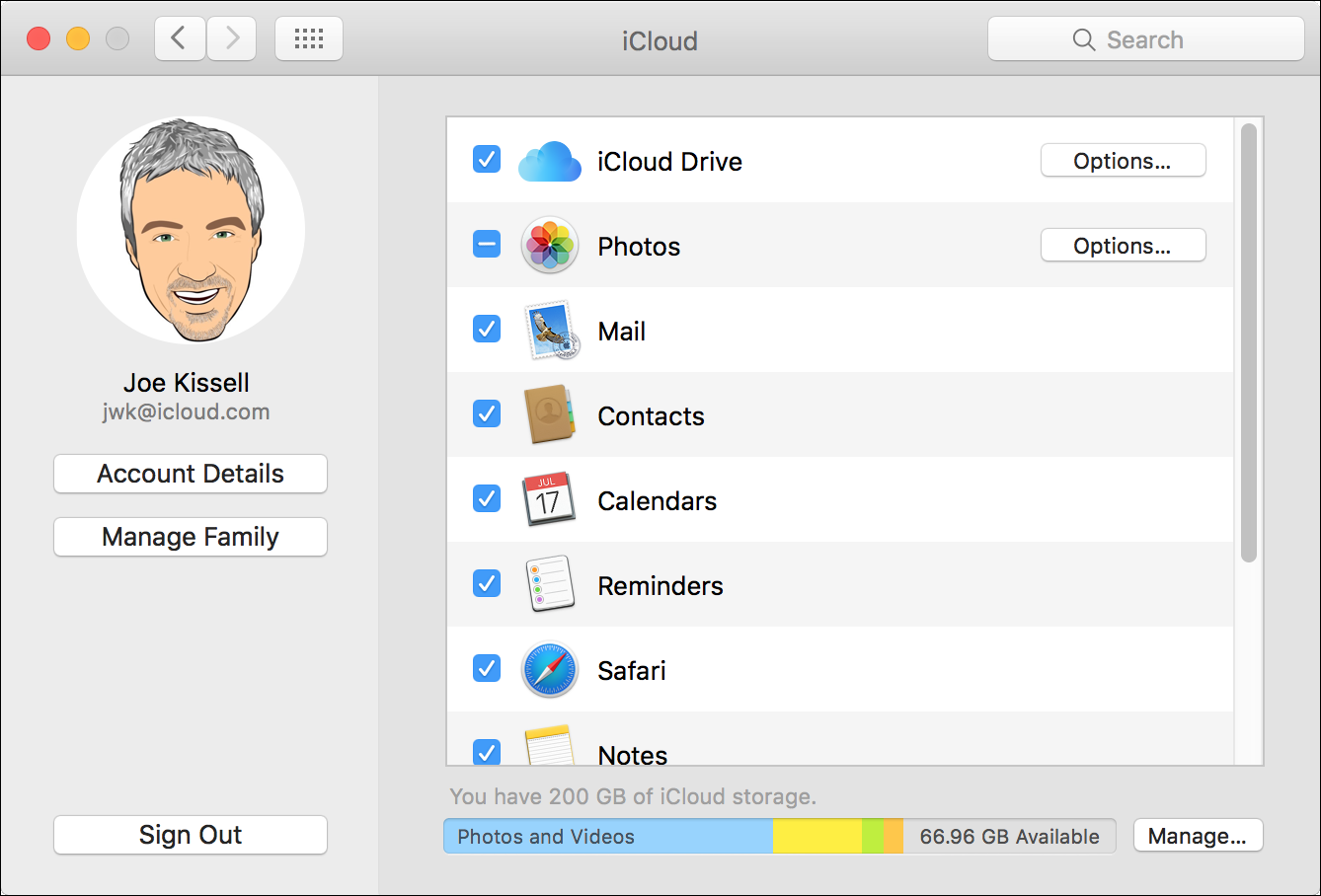
Figure 5: iCloud is finally (almost) ready to go in Mojave. Select or deselect checkboxes to specify the types of data you want to manage with iCloud. Unless you have some special reason to avoid one of these, I suggest selecting them all.
If you never previously set it up, Keychain requires an additional series of steps to set up, beyond merely selecting its checkbox. If you want to set it up now, flip ahead to Work with iCloud Keychain for instructions. Or leave it deselected for the moment and return to it when you’re ready. If you had Keychain enabled, turned it off, and are now turning it back on, you may again be faced with a series of alerts and password prompts.
When you’re satisfied with your settings, close System Preferences.
iCloud is now activated on your Mac, although you must take further steps to use the Music- or iTunes-specific features (see Use iCloud Music Features). Repeat this iCloud configuration process for any other user accounts on your Mac, as well as for any other Macs you may have, and then move on to set up your other devices.
Set Up iCloud for Windows
After you install iCloud for Windows (see Update Your Software), you can configure it with just a few steps.
The iCloud app may open automatically after you install it. If not, locate the iCloud app in the Start menu and open it. Then configure it as follows:
If prompted, enter your Apple ID and password, and click Sign In. If you use two-factor authentication or two-step verification (see Use Enhanced Security Features), follow the verification prompts.
The application should look something like Figure 6. (The storage indicator may be empty if you haven’t yet migrated any other devices, and other services may be checked or unchecked.)
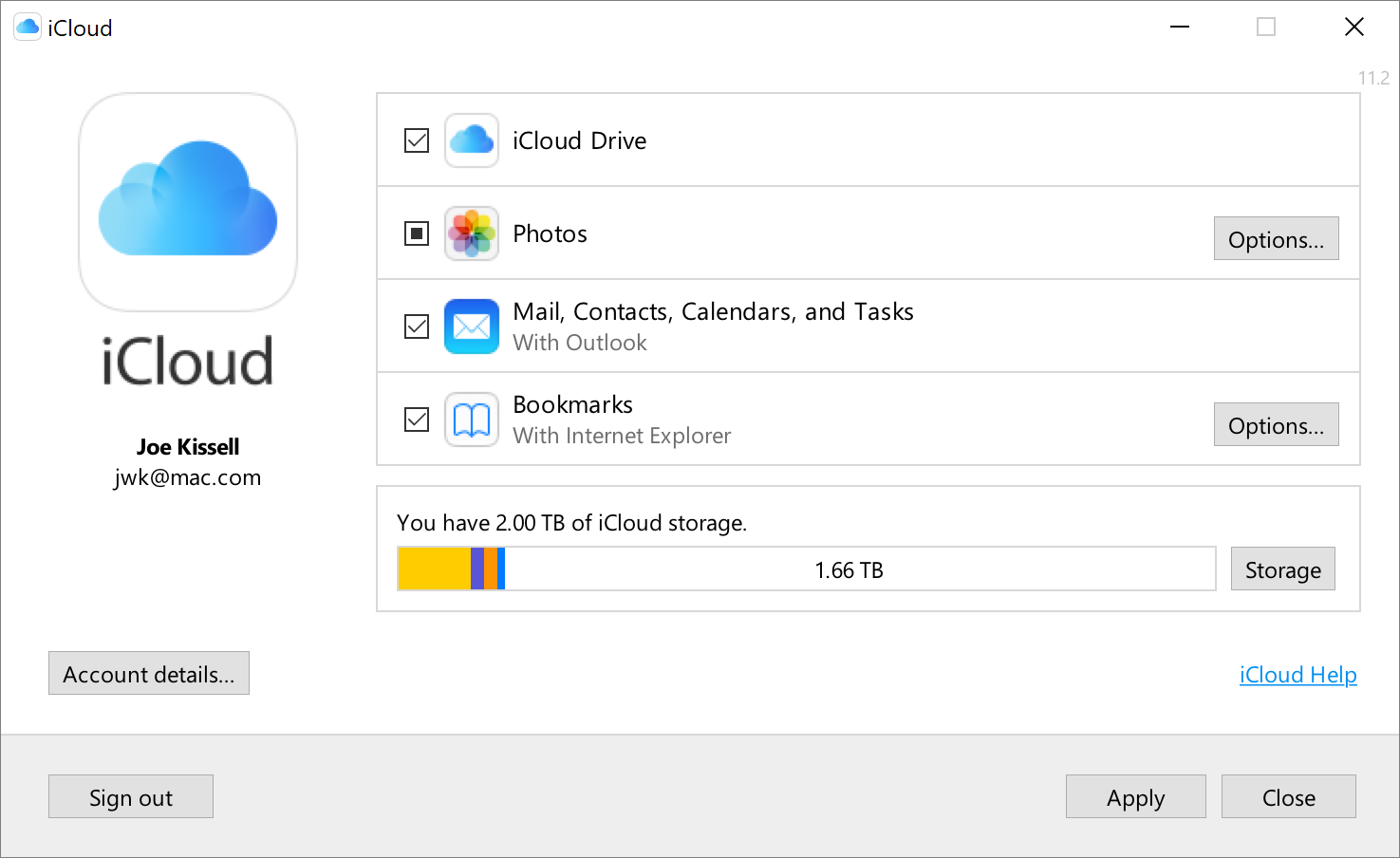
Figure 6: The iCloud app is now ready for your selections. For each service you want to enable, select the corresponding checkbox. (Unless you have a special reason not to, I suggest enabling them all.) However, note the following:
After turning on Photos, you can click its Options button for several additional settings. First, you can select iCloud Photos to turn on automatic uploads and downloads of photos and videos; that lets you then individually select or deselect “Download new photos and videos to my PC” and “Upload new photos and videos from my PC” (and select default folders for each). You can also select My Photo Stream (upload and download just recent photos) and iCloud Photo Sharing (to share photo streams with others and view photo streams others have shared with you). You can also specify a different iCloud Photo Sharing folder, if you don’t want to use the default folder (
C:\Users\your username\Pictures\iCloud Photos\Shared). Click Done when you’re finished.Mail, Contacts, Calendars, and Tasks can sync only with Microsoft Outlook 2016 or later. If your version of Outlook is earlier than 2016 (or if you don’t have Outlook installed at all), this item will be absent from the iCloud app, though you can still access this data from a web browser. With Outlook 2016 or later installed, when you enable Mail, Contacts, Calendars, and Tasks, you may be asked for your iCloud password one or more times.
When you select Bookmarks, an alert appears confirming that you want to merge your local bookmarks with any bookmarks already in iCloud. Click Merge. If the Bookmarks option is set to Internet Explorer and you prefer Firefox or Google Chrome (or any combination of these), then after turning on Bookmarks, click the Options button next to it, select the desired browser(s), and click OK. You’ll be prompted to install iCloud extensions for Firefox or Google Chrome. (As of mid-2020, bookmark syncing is still unavailable for Microsoft Edge.)
Click Apply to activate the selected services. Depending on the options you selected, various other windows and processes may open as iCloud completes its setup process and transfers your data. You may have to click Done to dismiss a progress window or two.
Click Close to close the iCloud app.
iCloud is now running in Windows. You must take more steps to use the iTunes-specific features (read Use iCloud Music Features).
Set Up iCloud in iOS or iPadOS
On an iOS or iPadOS device, proceed with the following tasks:
Tap Settings > Sign in to your Device. (After you sign in, you’ll instead see your name in this spot.)
Enter your Apple ID and password, and tap Sign In. If you have two-factor authentication enabled, follow the prompts to enter your verification code. You may also be prompted to enter your device’s passcode and, in certain situations, respond to other alerts.
Tap iCloud. In the list of services and apps that can sync data with iCloud (Figure 7), most should already be on (shown by a green switch). To toggle any service or app, tap its on/off switch.

Figure 7: Turn iCloud services on or off here (top shown on left; next portion on right). Options vary by device and version. Most people will want to have all the apps and services turned on; as the book progresses, I discuss these in more detail, but a few items that you may want to pay attention to now include:
For the most part, apps and data types that appear above iCloud Drive in the list are those that use iCloud for storage, but their data doesn’t appear as files visible in iCloud Drive. To prevent any of these items from syncing with iCloud, turn its switch off.
To turn iCloud Drive on or off, tap its on/off switch. You can also enable or disable iCloud Drive syncing for each supported app; apps appear below the iCloud Drive switch.
To turn on or off any iCloud photo syncing service—iCloud Photos, Upload to My Photo Stream, or Shared Albums—tap Photos (see Manage Your Photos for further details).
The Home switch lets iCloud sync settings from the Home app (for smart home products) across your iOS and iPadOS devices. But Home is not otherwise part of iCloud, so I don’t cover it in this book. (You can, however, learn all about the Home app and working with HomeKit devices in Take Control of Apple Home Automation by Josh Centers.)
The News switch lets data in the News app (such as favorites, history, and saved stories) sync among your iOS and iPadOS devices. (Because News is not an iCloud feature, I have nothing more to say about it in this book.)
The Health switch lets you sync data from the Health app on an iPhone with the cloud and with other iPhones you own. (Health data doesn’t sync with any other kinds of Apple hardware.)
The Wallet switch appears only on the iPhone and iPod touch, and lets you sync wallet items among multiple devices. These include Apple Pay credit cards, loyalty cards, concert tickets, and coupons. Because Wallet as such isn’t an iCloud feature, I don’t discuss it here.
The Siri switch enables information Siri learns about you on one of your devices to be shared with the others, to improve the quality of its responses. (To learn about Siri in detail, see Scholle McFarland’s book Take Control of Siri.)
The Keychain item, which controls iCloud Keychain, may require more than just a tap or two to configure. For full instructions, flip ahead to Work with iCloud Keychain.
To switch your iOS or iPadOS backup to iCloud from the Finder or iTunes, set iCloud Backup to On. (For more about iCloud Backup, see Understand How iCloud Backup Works.)
Your current storage statistics for iCloud Drive appear at the top of the screen. To get more detail about what’s backed up using iCloud Backup, or to delete the backed-up data for any app, tap Manage Storage. (See Activate and Configure iCloud Backup for details.)
iCloud is now set up on your iOS or iPadOS device. If you want to use iTunes Match or any of the other Music- or iTunes-related features, you must take steps that I describe in the next chapter. If you have any other iOS or iPadOS devices, repeat the above steps with each one now.
Work with Multiple iCloud Accounts
In this book, I generally assume that each person has a single iCloud account. Some people use a separate Apple ID for purchases from the iTunes Store (see About Your Apple ID). A separate account was often used to share purchases within a family, although Family Sharing largely eliminates that need (see Use iCloud Family Sharing).
However, in some situations a person may have more than one active iCloud account, each with its own set of data (such as email, contacts, and calendars). For example, you may have a personal account and a work account, or an individual work account and a departmental account that you’re in charge of monitoring. In cases such as these, you can set up your Mac or iOS/iPadOS device to access multiple iCloud accounts at once—with some restrictions. (You can also use this technique to share a set of contacts with a family member or friend; see Share Your Contacts with Someone Else, later.)
Use Multiple iCloud Accounts on a Mac
On a Mac, each user account can be signed in to a different iCloud account and receive nearly the full benefit of that iCloud account. There’s one important exception: Find My Mac can only be active for one iCloud account at a time, regardless of how many user accounts you’ve set up. If you want to enable Find My Mac under a different user’s account, first disable it under the user account where it’s active.
Apart from that, each user account on a Mac can have a primary iCloud account—with full access to all available services—as well as secondary iCloud accounts with more limited access. Once a given user has signed in to an iCloud account, that iCloud account becomes the primary account for that user, and the only one that can use iCloud Photos, iCloud Drive, and iCloud Keychain, or sync data from Home, News, Safari, Siri, and Stocks. If you then add another iCloud account while logged in to the same user account, your Mac treats the new iCloud account as secondary, which means it can be used only for email, contacts, calendars, and reminders. (And yes, you can have more than one secondary iCloud account.)
To add a secondary iCloud account, go to System Preferences > Internet Accounts, click iCloud, and follow the prompts to sign in and enable any desired features.
Use Multiple iCloud Accounts on an iOS or iPadOS Device
On an iOS or iPadOS device, as on a Mac, you can have more than one iCloud account set up, but only the first one you configure—the primary account—can be used for Backup, Home, Find My Device, iCloud Drive, iCloud Photos, Keychain, News, Safari, Siri, and Stocks. In addition, on an iOS or iPadOS device, push email works only with the primary account. Secondary accounts can be used for email, contacts, calendars, and reminders.
To add a secondary iCloud account, go to Settings > Accounts & Passwords > Add Account, tap iCloud, and follow the prompts.
Switch Primary and Secondary Accounts
You might set up an iCloud account as a secondary account on a Mac or iOS/iPadOS device and later decide you want it to be the primary, so it’s the one associated with services like iCloud Photos and iCloud Drive. To make that swap, follow these steps:
Remove the secondary account (see Remove an iCloud Account); this is a temporary change.
Sign out of the primary account.
Sign back in with what was formerly the secondary account that you are now making the primary account.
Now you can sign back in with the former primary account that you want to act as the secondary one.
Disable iCloud
Once you’ve set up an iCloud account, it exists forever. You can manually delete any or all of the information from the account, if you like, or even stop using it permanently, but Apple provides no way to cancel an iCloud account. However, even if you plan to continue using iCloud indefinitely, you may want to disable individual iCloud features, remove a device from Find My Device, or remove an iCloud account completely from a device.
Disable Individual Features
To disable features you don’t need, go to System Preferences > Apple ID > iCloud (Mac, Catalina or later), System Preferences > iCloud (Mac, Mojave), the iCloud app (Windows), or Settings > Your Name > iCloud (iOS or iPadOS). Uncheck or turn off the features you don’t want to use on that device. In some cases, you are prompted to decide whether you want to keep the associated data on your device or delete it; but even if you delete it from a given device, it will remain in the cloud, meaning it will download again if you later decide to reenable that feature.
Remove a Device from Find My Device
Find My Device on a Mac or iOS/iPadOS device lets the owner of the associated account lock or even wipe the contents of that device remotely if it’s lost or stolen.
That may have severe consequences if you buy or sell a Mac or iOS/iPadOS device with Find My Device still active: if you buy a used Mac or iOS/iPadOS device, the previous owner can erase your new device at any time! Before buying a used device, make sure that person has signed out of Find My Device; likewise, if you’re selling a device, make sure you’re signed out before it leaves your hands (see Check Activation Lock).
You can remove a device from Find My Device by turning off Find My Device in System Preferences > iCloud (on a Mac) or in Settings > Your Name > iCloud (on an iOS or iPadOS device); removing your iCloud account completely (described next); or, on an iOS or iPadOS device, by erasing it (tap Settings > General > Reset > Erase All Content and Settings). For more details, see Apple’s support article iCloud: Remove your device from Find My iPhone on iCloud.com.
Remove an iCloud Account
To remove an iCloud account from a device, do one of the following:
Mac: Go to System Preferences > Apple ID > Overview (Catalina or later) or System Preferences > iCloud (Mojave) and click Sign Out.
Windows: Open the iCloud app and click Sign Out.
iOS/iPadOS: Tap Settings > Your Name and then, at the bottom of that screen, tap Sign Out.
Then follow the prompts to specify whether you want any of your iCloud data to remain on the device.
Removing an iCloud account from a device, like disabling individual features, doesn’t delete data from Apple’s servers. If you later set up the same account on the device, it will re-download data for each iCloud feature you enable.